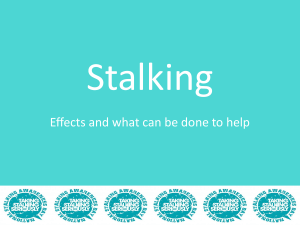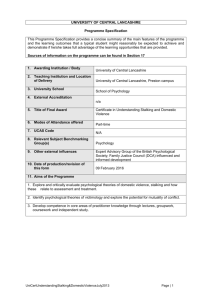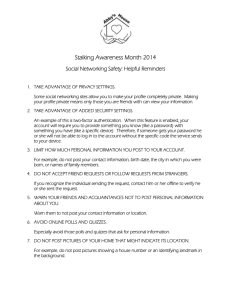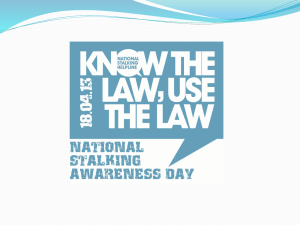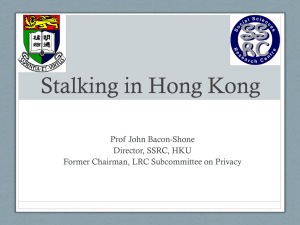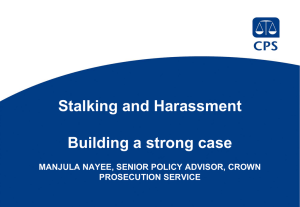Thesis Manuscript Final APPROVED
advertisement
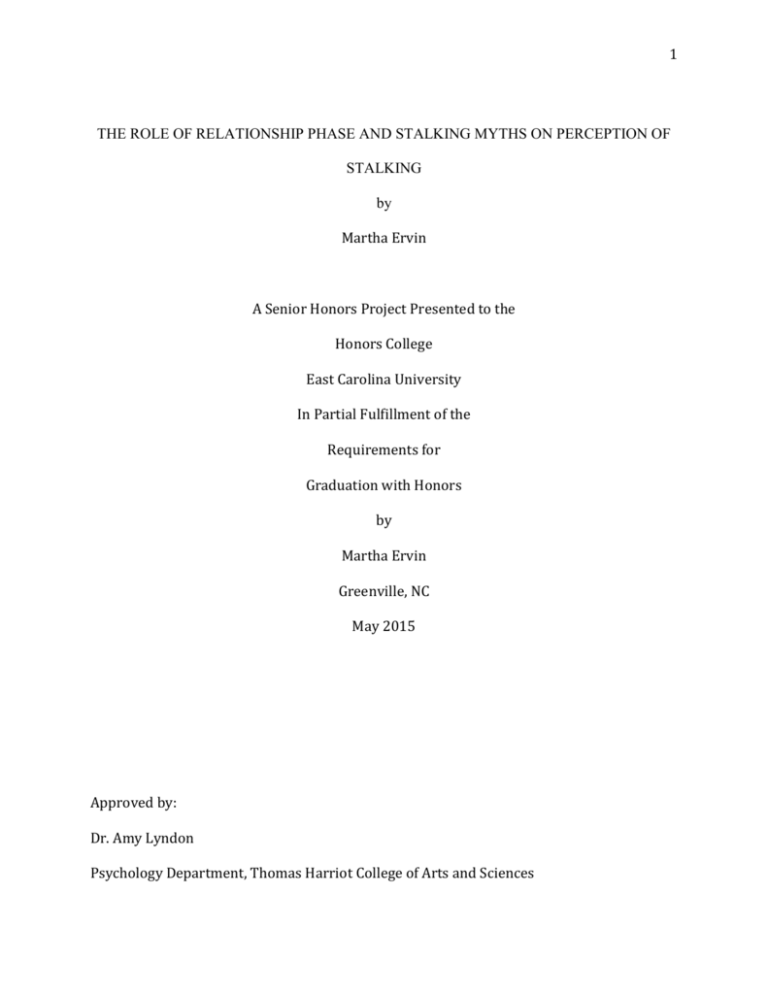
1 THE ROLE OF RELATIONSHIP PHASE AND STALKING MYTHS ON PERCEPTION OF STALKING by Martha Ervin A Senior Honors Project Presented to the Honors College East Carolina University In Partial Fulfillment of the Requirements for Graduation with Honors by Martha Ervin Greenville, NC May 2015 Approved by: Dr. Amy Lyndon Psychology Department, Thomas Harriot College of Arts and Sciences Running head: RELATIONSHIP PHASE AND STALKING STIGMA 2 Abstract Intimate partner violence (IPV) myths draw the following conclusions: the victim is blamed, the perpetrator is exonerated, and the situation is minimized (Lonsway, Cortina, & Magley, 2008; Payne, Lonsway, & Fitzgerald, 1999; Peters, 2008). There is evidence that stalking myths mirror these conclusions (Lyndon, Sinclair, & Martin, 2012). This study investigates the affect that relationship phase has on perceptions of stalking situations, as well as the relationship between attitudes and actual judgments of stalking. A total of 299 participants considered stalking behaviors in the context of a randomly assigned relationship phase in an online survey, rating the victim and perpetrator’s responsibility for the action and the seriousness of the behavior. Participants also completed a questionnaire assessing their endorsement of stalking myths. The results revealed that the phase of the relationship did not affect judgments of perpetrator or victim responsibility, or the seriousness of the situation. However, participants’ judgments of the victim and perpetrator’s responsibility and stalking severity were related with their stereotypical attitudes about stalking. Further testing revealed sex differences: men were more likely than women to endorse stalking myths and act upon those attitudes by exonerating the perpetrator and minimizing the situation. The relationship between biased attitudes and judgments of stalking could translate to lack of helping behavior in college students, which is problematic considering the commonality of stalking on college campuses (Fisher, Cullen, & Turner, 2002). Students, especially males, should be the targets of education interventions because their endorsement of stalking myths can have a real effect on stalking victims, perpetrators, and judgments of severity of a stalking situation. Running head: RELATIONSHIP PHASE AND STALKING STIGMA 3 The role of relationship phase and stalking myths on perception of stalking Stalking is a prevalent crime in the United States, with 8.2 million women and 2 million men reporting that they have been stalked at some point in their lifetime. Stalking behaviors include sending unwanted gifts, surveillance, unwanted phone communications, as well more violent behaviors such as physical threats or harm (Tjaden & Thoennes, 1998). Legally, stalking is “a course of conduct directed at a specific person that involves repeated visual or physical proximity, nonconsensual communication, or verbal, written, or implied threats, or a combination thereof, that would cause a reasonable person fear” (The National Criminal Justice project, 1993, p. 43-44). Intimate partner stalking is the most prevalent with 59% of female victims and 30% of male victims being stalked by intimate partners (Spitzberg, 2002; Tjaden & Thoennes, 1998). Stalking victims may be similarly stigmatized as other intimate partner violence (IPV) victims. Stigma refers to the relationship between a discrediting attribute possessed by an individual and the stereotype that accompanies it (Goffman, 1963). Stalking is a continuum of behaviors that can sometimes be positive (Dunn, 1999; Emerson, Ferris, & Gardner, 1998), which can affect outside perceptions of a stalking situation. As people stigmatize and blame victims for returning to an abusive partner (e.g., domestic violence victims), people may also blame stalking victims for reinstating the relationship with their stalker (Dunn, 1999; Emerson et al., 1998; Yamawaki, Ochoa-Shipp, Pulsipher, Harlos, & Swindler, 2012). This study hopes to answer several questions about stigma and stalking, such as whether judgments of stalking depend on the victim/perpetrator relationship. Specifically, I am interested in the effect that relationship phase has on perceptions of the stalking situation. No research has addressed stigma over the various stages of an intimate partner stalking relationship. The current Running head: RELATIONSHIP PHASE AND STALKING STIGMA 4 study will help us better understand how we stigmatize victims through common intimate partner violence (IPV) myths: blaming the victim, exonerating the perpetrator, and minimizing the stalking situation (Lonsway, Cortina, & Magley, 2008; Payne, Lonsway, & Fitzgerald, 1999; Peters, 2008). These stalking myths may be more evident and stigmatizing when victims return to or remain with the stalker, or if the perpetrator is trying to initiate a relationship with the victim. There is evidence that stalking myths also mirror these conclusions (Lyndon, Sinclair, & Martin, 2012). Stalking is another type of IPV because it is mostly perpetrated by intimate partners. Numerous studies have shown that ex-intimate partners are more likely to use violence and persist in stalking behaviors than their stranger counterparts (James & Farnham, 2003; Palarea, Zona, Lane & Langhinrichsen-Rohling, 1999; Sheridan & Davies, 2001). Stalking and domestic violence often overlap and domestic violence perpetrators commonly use stalking in pursuit of the victim (Coleman, 1997; Melton, 2007). Because intimate partners mostly perpetrate stalking and there are commonalities with other forms of IPV, parallels can be drawn between other types of IPV and stalking. Minimizing the situation. When the stalking situation is minimized, the actions of the perpetrator and the implications to the victim are not seen as serious or harmful. Intimate partner rape is perceived as less severe and less damaging to the victim than stranger rape (Monson, Byrd, & Langhinrichsen-Rohling, 1996; Syzmanski, Devlin, Chrisler, & Vyse, 1993). Like other forms of IPV, intimate partner stalking is not as likely to be seen as stalking or a threat as other types of stalking. Behaviors perpetrated by a stranger are more likely to be perceived by participants as more frightening and alarming than those of a former intimate partner (Dunn, 1999; Scott & Sheridan, 2011). Intimate partner stalking is less likely to be seen as necessitating Running head: RELATIONSHIP PHASE AND STALKING STIGMA 5 law enforcement intervention and criminal prosecution than stranger stalking (Scott & Sheridan, 2011). There is evidence that women perceive stalking interactions perpetrated by a former intimate more positively than when the behaviors are perpetrated by a non-intimate (Dunn, 1999). Victim blame. In an analysis of an IPV online forum and interviews with police officers, domestic violence shelter staff, and shelter clients, researchers found that domestic violence victims were often blamed for the abuse. Non-victim participants believed that victims could exit the situation whenever they wanted to, regardless of the social, economic, or familial consequences (Westbrook, 2009). Similarly, stalking victims are more likely to be perceived as encouraging stalking behavior when the perpetrator is a former intimate rather than a stranger (Scott, Gavin, Sleath, & Sheridan, 2014; Scott & Sheridan, 2011). Perpetrator exoneration. In sexual harassment, attribution of blame can depend on the actions of the victim and others around them. If others around the victim are not uncomfortable with the perpetrator’s behavior, or the victim does not respond to the perpetrator consistently, the perpetrator is not likely to be blamed for his or her actions (Klein, Apple, & Kahn, 2011). Similarly, Scott, Nixon, and Sheridan, (2013) found that the general public and law enforcement officers not on family crisis or domestic violence task force units believe that intimate partner stalkers are not as dangerous and required less intervention than stranger and acquaintance stalkers. The authors also found that non-specialized law enforcement officers believe that intimate partner stalking perpetrators do not cause much damage to the victim compared to nonintimate partner stalkers. Former intimate partner perpetrators are less likely to be criminally prosecuted and convicted in stalking cases than non-intimates (Scott et al., 2014; Sheridan & Davies, 2001). If intimate partners are seen as less dangerous, then perhaps stalking to initiate a Running head: RELATIONSHIP PHASE AND STALKING STIGMA 6 relationship will be seen as even less of a threat. The phase of the relationship may dictate whether or not the victim will be blamed, the perpetrator will be exonerated, and the situation will be minimized. Courtship It is hard to draw the line between stalking and courtship because behaviors that can be considered stalking are often normal in the relationship initiation (Emerson et al., 1998). The same behaviors may be seen as normal or desirable during courtship, but as negative or even frightening after a relationship (Dunn, 1999; Sinclair & Frieze, 2000). These behaviors can sometimes be classified as “pre-stalking.” Pre-stalking practices include unwanted written or electronic contact, showing up uninvited, and obtaining personal information about the victim. These actions can lead to severe stalking but are perceived as normal friendship or courtship tactics. These behaviors may only be recognized as stalking tactics retrospectively (Emerson et al., 1998). Sinclair and Frieze (2000) examined unrequited love and when courtship ends and stalking begins. Stalking and normal relationship pursuit tactics are startlingly similar. Normal relationship pursuit often involves persistence, which can closely resemble stalking. Pursuit tactics become stalking when the behaviors are unwanted and legally becomes stalking when fear may be involved. The majority of pursuers stop courtship pursuit before intimidation is used and targets become afraid. However, Sinclair and Frieze show that it is difficult to draw a clear line between what constitutes as normal courtship and abnormal behavior, especially concerning non-violent behaviors. For example, Dunn (1999) found that even when a situation causes the victim fear or annoyance, romantic imagery and behaviors might complicate perceptions of it. Fifty-six percent of women felt that an ex-boyfriend showing up uninvited with flowers was at Running head: RELATIONSHIP PHASE AND STALKING STIGMA 7 least moderately romantic while only 20% of women felt an ex-boyfriend showing up without flowers was romantic. When romance is mingled with unwanted interaction, cultural norms that dictate that women should be flattered by romantic gestures can cause them to label the situation as normal. Returning Stalking victims may be similarly stigmatized for returning to their abusive relationship. A common instance of a victim returning to intimate partner violence occurs in domestic violence, in which victims often attempt to leave several times before successfully cutting ties with the abuser. Reasons for a victim returning to the abuser in domestic violence sometimes include economic instability, lack of shelter, and police inaction, among others, such as investment in the relationship; other victims return because the abuser promises to change or apologizes (Anderson et al., 2003; Strube & Barbour, 1983). Regardless, domestic violence victims who return to their abuser are blamed more than the abuser and are perceived as responsible for the abuse (Yamawaki et al., 2012). One third of participants in one study believed that victims remained in domestic violence situations because they enjoy the perpetrator’s attention (Policastro & Payne, 2013). Little research has been done concerning stalking victims returning to the perpetrator. However, Davis, Ace, and Andra (2000) found that individuals who were dumped in a relationship were more likely to use stalking behaviors as a tool to attempt to reestablish the relationship and communicate love to the victim. The same study found that in relationships with a “Velcro” history (a pattern of frequent breakups and reunions), the number of breakups and reunions were a contributing factor to the perpetration of stalking. Though no research has been done concerning perceptions of stalking and reestablished relationships, stalking as a method of relationship reunification does occur; parallels may be able to be drawn Running head: RELATIONSHIP PHASE AND STALKING STIGMA 8 between domestic violence and returning to the abuser and perceptions of the victim. Hypotheses Based upon the research above, the following questions were posed: Do people stigmatize stalking targets for returning to their pursuer? What's the level of acceptability of courtship stalking behaviors? Does the phase of the relationship affect perceptions of perpetrator behaviors (exonerating perpetrator) and victim behavior (victim blame)? In response to the research questions, the following hypotheses are proposed: 1) the victim will be blamed more when she returns to the abuser than those who do not return, 2) the perpetrator will be exonerated more when trying to initiate or reestablish the relationship than when currently in a relationship or broken up, 3) the situations will be minimized as not stalking during courtship and after the relationship has been reestablished than when in a relationship or broken up, and 4) people who endorse stalking myths will blame the victim, exonerate the perpetrator, and minimize the situation more than those who do not endorse stalking myths. Method Design A 4 (phase of the relationship: courtship, a sour relationship, after a relationship has ended, and after a relationship has been reinstated) independent-groups design was used. Participants Participants were 299 (219 women, 80 men) students at a large university in the southeastern United States in the Psychology Department participant pool. Participants received partial class credit for participating in the online survey. Of those who participated in the study, 67.2% were Caucasian, 17.1% were African American, 4.3% were Latino/Hispanic, 3% were Asian/Pacific Islander, 1% were Middle Running head: RELATIONSHIP PHASE AND STALKING STIGMA 9 Eastern, 0.7% were Native American, 5.7% were of mixed race, and 0.3% identified as another race. Two participants declined to identify their race. Heterosexuals made up the majority of participants (94.6%), while bisexuals made up 2.3% of the sample and lesbians, gay men, and other sexualities each made up 1%. In terms of relationship status, 48.8% of participants were single, 9.4% were in a casual dating relationship, 40.8% were in a committed dating relationship, 0.3% were married, and 0.7% were separated. Participant ages ranged from age 18 to 26 or older. 51.2% of participants were eighteen, 30.4% were nineteen, 13.4% were twenty, 3% were twentyone, 1% were twenty-two, and twenty-three year olds and 26 year olds and older each made up 0.3% of the sample. One participant declined to disclose age. Procedure Prior to the survey, the purpose and method of the study were explained to participants and all participants gave informed consent. Participants received the modified ORI survey, stalking myths scale, and the demographics survey online. Using electronic randomization, participants were randomly assigned to one of four relationship prompt groups and told to consider the listed behaviors on the modified ORI survey during one of the following relationship phases: trying to start a relationship, during a relationship that has gone sour, after a relationship ends, and after a relationship ends but the victim returns. Afterwards, all four groups received the stalking myths survey and demographics survey. Materials Relationship phase prompts. The relationship phase was manipulated by giving participants a prompt that instructed them to consider the stalking behaviors in the context of a certain relationship phase. Participants rated stalking behaviors indicating the acceptability of the behavior in the context of the phase of the relationship. The prompts were as follows: Running head: RELATIONSHIP PHASE AND STALKING STIGMA 10 Courtship: “Please imagine Steven and Emily, who met in class. Steven wants to date Emily. In the process of trying to get her to date him, Steven pursues her using some of the following behaviors, which Emily didn't welcome. In this context, please consider the following behaviors.” Sour Relationship: “Please imagine Steven and Emily, who met in class and are currently dating, but the relationship isn't going well. In the process of trying to keep the relationship together, Steven pursues her some of the following behaviors, which Emily didn't welcome. In this context, please consider the following behaviors.” Broken Up: “Please imagine Steven and Emily, who met in class and recently broke up their relationship. In the process of trying to get back together, Steven pursues her some of the following behaviors, which Emily didn't welcome. In this context, please consider the following behaviors.” Back Together: “Please imagine Steven and Emily, who met in class, had in a romantic relationship and broke up, but got back together. In this context, consider each question for each behavior below. In the process of trying to get back together, Steven pursued her some of the following behaviors, which Emily didn't welcome. In this context, please consider the following behaviors.” Stalking behaviors. The study utilized a modified version of Spitzberg & Cupach’s (2014) Obsessive Relation Intrusion (ORI). The survey was originally intended to measure the actual perpetration of victimization, but it was modified to assess the acceptability of components of intimate partner violence myths. Participants were asked the extent to which the victim was responsible (victim blame), the extent to which the perpetrator was responsible Running head: RELATIONSHIP PHASE AND STALKING STIGMA 11 (perpetrator exoneration), and the severity of the behavior (minimizing the situation) in the context of their relationship phase prompt. The survey consisted of 73 items. A sample item is, “Making appearances (e.g., showed up at her work, school, gym, place of worship, etc.)” Participants indicated their perception of victim responsibility, perpetrator responsibility, and situation severity on a four-point not at all to completely Likert scale. The mean of each of the subscales of the ORI responses were averaged for each question, creating three subscales of judgments of perpetrator exoneration, victim blame, and minimization. Stalking Myths Survey. Stalking myth endorsement was measured with the stalking myth survey (Lyndon, Sinclair, & Martin, 2012). The survey consisted of 37 questions from three subscales: minimization, victim blaming, and stalking as courtship (i.e., perpetrator exoneration). A sample item from the 17-item minimization subscale is “Stalking is not a joke.” The minimization subscale was highly reliable, (α = .89). A typical item from the nine-item victim blaming subscale is “Certain types of people are more likely to be stalked.” The victimblaming subscale was also highly reliable, (α = .86). An example of an item from the 12-item perpetrator exoneration subscale is “People find it flattering to be persistently pursued.” Like the other subscales, the perpetrator exoneration subscale was highly reliable, (α = .85). All items used a six-point strongly disagree to strongly agree Likert scale. Some items were reverse coded. Subscales of minimization, victim blaming, and perpetrator exoneration were created using the mean of each subscale. Higher scores on each subscale equal more minimization, more victim blame, and less general responsibility for the perpetrator. Results MANOVAs were used to test hypotheses 1-3. For Hypothesis 1, Prompt 4 was compared to Prompts 1, 2, and 3 in order to test if victim blame was higher if the victim returned to the Running head: RELATIONSHIP PHASE AND STALKING STIGMA 12 stalker than during courtship, a sour relationship, or in a relationship that was broken up. A oneway MANOVA showed no significant differences in victim blame judgments in Prompt 4 versus Prompts 1, 2, and 3, (1,270) = 1.12, p = .34 (see table 1 for details). Participants did not blame the victim more when the victim returned to the perpetrator versus the other relationship phases; hypothesis 1 was not supported. Hypotheses 2 and 3 were also not supported. Prompts 1 and 4 were compared to Prompts 2 and 3 in order to test if the perpetrator was exonerated more or the situation was taken less seriously in courtship and relationship reestablishment than in a sour relationship or a relationship that has been broken up. A one-way MANOVA revealed no significant differences in participant judgments between Prompts 1 and 4 and Prompts 2 and 3 on perpetrator exoneration and situation seriousness, F(1, 270) = .52, p = .67 (see table 2). Participants did not exonerate the perpetrator or minimize the situation more in the courtship and returning situations more than in a relationship that was sour or broken up. Supporting hypothesis 4, participants’ stalking myth attitudes are all correlated in the expected directions with their judgments about potential stalking victims (see table 3). Victim blame attitudes were correlated with blaming the victim in all of the stalking prompts. Endorsement of the myth of perpetrator exoneration was related to lower judgments of the perpetrators’ responsibility. Endorsement of the myth of minimization was related to reduced judgments of severity of the stalking situation. After the initial analyses were performed, post hoc tests were conducted to assess sex differences in participants’ responses. Sex differences were seen in judgments on all prompts of the ORI, F (1, 287) = 5.00, p = .002 (see table 4 for details). Men did not think stalking behaviors are as serious as did women. Women were more likely to assign responsibility to the perpetrator for his behaviors than men. Sex differences were seen in participants’ scores on the Running head: RELATIONSHIP PHASE AND STALKING STIGMA 13 SMS, F (1, 287) = 9.21, p = .001. Men are more likely than women to endorse the staking myths of victim blame, perpetrator exoneration, and minimization. Discussion Based upon these tests, the phase of the relationship (i.e., relationship prompt) did not affect judgments of perpetrator responsibility, victim responsibility, or the seriousness of the situation. Hypothesis 4 was supported; participants’ stereotypical attitudes about stalking were all related with their judgments of the hypothetical victim and perpetrator’s responsibility and stalking severity. Participants who had attitudes consistent with stalking myths judged stalking situations according to those attitudes, regardless of relationship phase. Similar judgments are found in the only other study regarding stalking myths: general practitioner doctors and police officers in the European Union who endorsed stalking myths were less willing to get professionally involved in a stalking situation (Kamphuis et al., 2005). The majority of stalking literature is not concerned about variations within intimate relationships; rather, most studies examine intimate partner, acquaintance, and stranger stalking (e.g., Scott & Sheridan, 2011). This gap makes comparing the current study to the stalking literature difficult. However, the current study seems consistent with some of the findings of courtship stalking literature. Courtship stalking tactics can be viewed as normal relationship pursuit, and are even encouraged and romanticized in our culture (Dunn, 1999; Sinclair & Frieze, 2000). Participants in the current study chose not to blame either the victim or the perpetrator for the perpetrator’s stalking behaviors. The lack of responsibility attributions could be due to the fact that using less severe unwanted pursuit behaviors to initiate or continue a relationship is too commonplace (Langhinrichsen-Rohling, Palarea, Cohen, & Rohling, 2000; Sinclair & Frieze, 2000) to warrant the attribution of blame. Concerning the more severe behaviors included in this Running head: RELATIONSHIP PHASE AND STALKING STIGMA 14 study, it may be that people see high severe stalking behaviors like physical violence as wrong, no matter the phase of the relationship. The combination of the perceived normality of some behaviors and abnormality of others could have created the lack of overall blame attribution in the current study. In future research it may be wise to limit the behaviors examined to those that are non-violent and less severe. Removing the more severe behaviors may better reveal blame attributions. The results of the current study appear to be inconsistent with those of other findings of the courtship stalking literature, though. In the courtship stalking prompt, the behaviors were judged just as serious as those in other relationship phases. This result appears to contradict to the apparent minimization of seriousness by sorority women in Dunn’s (1999) research. In her research, Dunn did not include as many severe behaviors for participants to examine – she mainly focused on mid-level severity behaviors. Further, the most severe behavior in Dunn’s study was the perpetrator threatening suicide – an act not directly threatening to the victim. The current study included a wide variety of behaviors, with many that would be considered extremely severe (i.e., kidnapping, sexual coercion, etc.) to the victim, which could have prompted higher severity ratings. The differences in behavior severity could explain the lack of minimization in the current study versus in Dunn (1999). The refocusing of future research concerning stalking myths to only examine lower-level and mid-level stalking behaviors could also reveal clearer patterns of minimization. The current study found no stigma associated with returning to the stalker. It is commonplace for ex-partners to engage in stalking behavior to reunite with their partners (Davis et al., 2000). It is plausible that participants viewed stalking behaviors as normal tools in relationship maintenance since neither the victim nor the perpetrator was blamed in the current Running head: RELATIONSHIP PHASE AND STALKING STIGMA 15 study. However, the current research is inconsistent with that of domestic violence and victims returning to abusive relationships. Domestic violence victims are often blamed for returning to their abusers, which can equate to a lack of social support that sometimes drives them back into the violent relationship (Yamawaki et al., 2012). The current study did not find that stalking victims reestablishing a relationship with a former intimate partner were blamed any more than in other relationship phases. People may view stalking with less stigma than domestic violence, since stalking violence is not necessarily physical and many non-violent tactics are used. This perception could have caused participants to not attribute as much responsibility to the victim in the stalking situation. The current study is also inconsistent with the perceptions of stalking literature in that we used short prompts instead of detailed vignettes (e.g., Dennison & Thomson, 2000; Scott & Sheridan, 2011), which could shape participants’ responses. In future research, it may be applicable to give a longer vignette with a clear pattern of breaking up and getting back together, which may be a more realistic portrayal of a reestablishment of a relationship due to stalking behaviors (Davis et al., 2000). Perhaps if the situation detailed with more instances of the victim returning to the perpetrator, participants will perceive the situation differently. Further testing revealed sex differences in the data. Men were more likely to hold attitudes consistent with all stalking myths – perpetrator exoneration, victim blame, and minimization – than were women. Men were also more likely to actually act upon those attitudes, as they were less likely to judge a stalking situation as serious and more likely to attribute less responsibility to the perpetrator than were women. Men and women were equally likely to not blame the victim. These results are consistent with previous research concerning college students’ perceptions of stalking (Lambert, Smith, Geistman, Cluse-Tolar, & Jiang, 2013). The findings of the current study are also consistent with IPV literature: men are more Running head: RELATIONSHIP PHASE AND STALKING STIGMA 16 likely to endorse IPV myths than are women (e.g., Basow & Minieri, 2011; Clarke & Stermac, 2011; Policastro & Payne, 2013). However, these results are not entirely consistent with all of the previous literature concerning IPV myth endorsement. For instance, Yamawaki et al. (2012) examined perceptions of domestic violence victims who returned to the abuser found that men were more likely to blame the victim and minimize the situation, but not more likely than women to make excuses for the perpetrator. Since domestic violence perpetrators’ behaviors involve physical violence, men may make fewer excuses for perpetrators than in a non-violent stalking situation. This viewpoint could also explain the differences in male participants’ not actually attributing responsibility the victim in the stalking situation while still holding attitudes consistent with the stalking myth of victim blame. Limitations One limitation of the current study is the length of the survey. Many participants did not complete the survey or did not take it correctly. Participants who took too short a time to complete the survey, who had clear answer patterns of error, and who missed the validity check question were eliminated, which reduced the number of participants included in the analysis. A greater number of participants may have revealed more in the data. Another limitation is the ratio of men to women who participated in the current study. Because 26% of the sample were men, it may be harder to compare women and men with such a gender imbalance. Future research should attempt to obtain a sample that is more gender balanced. A perceived limitation of the current research is the fact that all participants were college students, meaning that the results cannot be generalized outside of a college campus. However, this is actually a targeted sample between 17.5% and 46% of female college students and 2.9% to 23.5% of male college students are pursued and stalked (Lyndon et al., 2012). This study’s findings are relevant to the studied Running head: RELATIONSHIP PHASE AND STALKING STIGMA 17 population, and could be applied in future research on the college population. Conclusions/Implications It is important to consider how people view stalking: whether professionals and laypeople alike support victims, take them seriously, and hold perpetrators accountable for their actions. The current study reveals that people that have biased attitudes about stalking are more likely to make real world judgments according to those preconceptions. The judgments that the public makes can affect on the way victims and perpetrators are treated. Only half of all stalking charges taken to court result in convictions, and former intimate partner stalking cases are less likely to make it to court and result in convictions than other types of stalking (Scott et al., 2014; Tjaden & Thoennes, 1998). Given the conviction rates of stalkers in the criminal justice system, it is pertinent to examine the college students’ perceptions, since it is common phenomenon on college campuses (Fisher, Cullen, & Turner, 2002). Participants in the current study who had attitudes consistent with stalking myths actually judged the victim, perpetrator, and situation according to those attitudes. These judgments could translate into a lack of helping behavior directed to victims by their peers. The holding of biased attitudes of stalking, as well as the tendency to act upon those preconceptions, could be more problematic in students since some universities are less likely to label stalking as a crime and more likely to label it a violation of the honor code. Universities need to educate students on the seriousness of stalking and resources available to victims in order to improve perceptions of and responses to stalking situations on college campuses (Truman & Mustaine, 2009). Future research should continue to examine the perceptions that students hold regarding intimate partner stalking, as well as actual judgments that they make in response to a stalking situation. Further, future research should also include campus police officers, since Running head: RELATIONSHIP PHASE AND STALKING STIGMA 18 stalking is so widespread on college campuses (Fisher, Cullen, & Turner, 2002) and police officers in other studies with attitudes consistent with stalking myths are less likely to participate in professional helping behaviors (Kamphuis et al., 2005). The sex differences revealed in the current study should also be taken seriously, especially since previous research has revealed similar attitudes in a college sample (Lambert et al., 2013). In a mock trial, male college students were less likely than women college students to convict an intimate partner stalker. When asked about their opinions of the defendant and victim, women were more likely than men to have a positive perception of the victim and negative perception of the perpetrator (Dunlap, Hodell, Golding, & Wasarhaley, 2011). Like in the current study, the results of the mock trial highlight the relationship between previous attitudes and actual judgments, as well as the sex differences in attitudes and judgments about stalking. Future research should consider why these sex differences exist, as well as what can be done to reduce them, especially on college campuses. The current study’s results could be applied in future research concerning college students, as well as in interventions on college campuses. Students should be the targets of education because of their endorsement of stalking myths can have a real effect on stalking victims, perpetrators, and judgments of severity of a stalking situation. Based on literature plus current study, men are of particular of interest because of their tendency to judge stalking perpetrators less severely than women. In any case, much is yet to be discovered about perceptions of the phenomenon of stalking – especially taking a more nuanced approach to intimate partner stalking. Running head: RELATIONSHIP PHASE AND STALKING STIGMA 19 References Anderson, M.A., Gillig, P.M., Sitaker, M., McCloskey, K., Malloy, K., & Grigsby, N. (2003). “Why doesn’t she just leave?”: A descriptive study of victim reported impediments to her safety. Journal of Family Violence, 18(3), 151-155. doi:10.1023/A:1023564404773 Basow, S.A., & Minieri A. (2011). ‘You owe me.’ Effects of date cost, who pays, participant gender, and rape myth beliefs on perceptions of rape. Journal of Interpersonal Violence, 26(3), 479-497. doi:10.1177/0886260510363421 Clarke, A.K., & Stermac L. (2011). The influence of stereotypical beliefs, participant gender, and survivor weight on sexual assault response. Journal of Interpersonal Violence, 26(11), 2285-2302. doi:10.1177/0886260510383039 Coleman, F.L. (1997). Stalking behavior and the cycle of domestic violence. Journal of Interpersonal Violence, 12(3), 420-432. doi:10.177/088626097012003007 Davis, K.E., Ace, A., & Andra, M. (2000). Stalking perpetrators and psychological maltreatment of partners: Anger-jealousy, attachment insecurity, need for control, and break-up context. Violence and Victims, 15(4), 407-425. Dennison, S., & Thomson, D.M. (2000). Community perceptions of stalking: What are the fundamental concerns? Psychiatry, Psychology, and Law, 7(2), 159-169. doi:10.1080/13218710009524982 Dunlap, E.E., Hodell, E.C., Golding, J.M., & Wasarhaley, N.E. (2012). Mock jurors’ perception of stalking: The impact of gender and expressed fear. Sex Roles, 66, 405-417. doi: 10.1007/s11199-011-9970-z Running head: RELATIONSHIP PHASE AND STALKING STIGMA 20 Dunn, J.L. (1999). What love has to do with it: The cultural construction of emotion and sorority women’s responses to forcible interaction. Social Problems, 46(3), 440-459. doi:10.2307/3097109 Emerson, R.M., Ferris, K.O., & Gardner, C.B. (1998). On being stalked. Social Problems, 45(3), 289-314. doi:10.2307/3097188 Fisher, B. S., Cullen, F. T., & Turner, M. G. (2002). Being pursued: Stalking victimization in a national study of college women. Criminology and Public Policy, 1, 257-308. doi:10.1111/j.1745-9133.2002.tb00091.x Goffman, E. (1963). Stigma: Notes on the management of spoiled identity. Englewood Cliffs, N.J.: Prentice-Hall. James, D.V., & Farnham, F.R. (2003). Stalking and serious violence. Journal of the American Academy of Psychiatry and the Law, 31(4), 432-439. Kamphuis, J.H., Galeazzi, G.M., Fazio, L.D., Emmelkamp, P.M., Farnham, F., Groenen, A., James, D., & Vervaeke, G. Stalking – Perceptions and attitudes amongst helping professions. An EU cross-national comparison. Clinical Psychology & Psychotherapy, 12(3), 215-225. doi:10.1002/cpp.451 Klein, K.M., Apple, K.J., & Kahn, A.S. (2011). Attributions of blame and responsibility in sexual harassment: Reexamining a psychological model. Law and Human Behavior, 35(2), 92-103. doi:10.1007/s10979-009-9216-6 Lambert, E.G., Smith, B., Geistman, J., Cluse-Tolar, T., & Jiang, S. (2013). Do men and women differ in their perceptions of stalking: An exploratory study among college students. Violence and Victims, 28(2), 195-209. doi:10.1891/0886-6708.09-201 Running head: RELATIONSHIP PHASE AND STALKING STIGMA 21 Langhinrichsen-Rohling, J., Palarea, R.E., Cohen, J., & Rohling, M.L. (2000). Breaking up is hard to do: Unwanted pursuit behaviors following the dissolution of a romantic relationship. Violence and Victims, 15(1), 73-90. Lonsway, K.A., Cortina, L.M., & Magley, V.J. (2008). Sexual harassment mythology: Definition, conceptualization, and measurement. Sex Roles, 58(9-10), 599-615. doi:10.1007/s11199-007-9367-1 Lyndon, A. E., Sinclair, H. C., & Martin, S. (February 2012). Validation of the stalking myth survey, revised. Poster presented at the 58th annual meeting of the Southeastern Psychological Association, New Orleans, LA. Melton, H.C. (2007). Predicting the occurrence of stalking in relationships characterized by domestic violence. Journal of Interpersonal Violence, 22(3), 3-25. doi:10.1177/0886260506294994 Monson, C.M., Byrd, G.R., & Langhinrichsen-Rohling, J. (1996). To have and to hold: Perceptions of marital rape. Journal of Interpersonal Violence, 11(3), 410-424. doi:10.1177/088626096011003007 National Criminal Justice Association. (1993, October). Project to develop a model anti-stalking code. Washington, D.C: U.S. Department of Justice, National Institute of Justice. Palarea, R. E., Zona, M.A., Lane, J.C., & Langhinrichsen-Rohling, J. (1999) The dangerous nature of intimate relationship stalking: Threats, violence, and associated risk factors. Behavioral Sciences & the Law, 17(3), 269-283. doi:10.1002/(SICI)10990798(199907/09)17:3<269::AID-BSL346>3.0.CO;2-6 Running head: RELATIONSHIP PHASE AND STALKING STIGMA 22 Payne, D.L., Lonsway, K.A., & Fitzgerald, L.F. (1999). Rape myth acceptance: Exploration of its structure and its measurement using the Illinois rape myth acceptance scale. Journal of Research in Personality, 33(1), 27-68. doi:10.1006/jrpe.1998.2238 Peters, J. (2008). Measuring myths about domestic violence: Development and initial validation of the domestic violence myth acceptance scale. Journal of Aggression, Maltreatment & Trauma 16(1), 1-21. doi:10.1080/10926770801917780 Policastro, C., & Payne, B.K. (2013). The blameworthy victim: Domestic violence myths and the criminalization of victimhood. Journal of Aggression, Maltreatment, & Trauma, 22(4), 329-347. doi:10.1080/10926770801917780 Scott, A.J., Gavin, J., Sleath, E., & Sheridan, L. (2014). The attribution of responsibility in cases of stalking. Psychology, Crime, and Law, 20(7), 705-721. doi:10.1080/1068316X.2013.854793 Scott, A.J., Nixon, K., & Sheridan, L. (2013). The influence of prior relationship on perceptions of stalking: A comparison of laypersons, nonspecialist police officers, and specialist police officers. Criminal Justice and Behavior, 40(12), 1434-1448. doi:10.1177/0093854813494183 Scott, A. J., & Sheridan, L. (2011). ‘Reasonable’ perceptions of stalking: The influence of conduct severity and the perpetrator-target relationship. Psychology, Crime & Law, 17(4), 331-343. doi:10.1080/10683160903203961 Sheridan, L., & Davies, G.M. (2001). Violence and the prior victim-stalker relationship. Criminal Behaviour and Mental Health, 11(2), 102-116. doi:10.1002/cbm.375 Running head: RELATIONSHIP PHASE AND STALKING STIGMA 23 Sheridan, L., & Lyndon, A. E. (2012). The influence of prior relationship, gender, and fear on the consequences of stalking victimization. Sex Roles, 66(5-6), 340-350. doi:10.1007/s11199-010-9889-9 Sinclair, H.C., & Frieze, I.H. (2000). Initial courtship behavior and stalking: How should we draw the line? Violence and Victims, 15(1), 23-40. Spitzberg, B.H. (2002). The tactical typography of stalking victimization and management. Trauma, Violence, & Abuse, 3(4), 261-288. doi:10.1177/1524838002237330 Strube, M.J., & Barbour, L.S. (1983). The decision to leave an abusive relationship: Economic dependence and psychological commitment. Journal of Marriage and Family, 45(4), 785-793. doi:10.2307/351791 Syzmanski, L.A., Devlin, A.S., Chrisler, J.C., & Vyse, S.A. (1993). Gender role and attitudes toward rape in male and female college students. Sex Roles, 29(1-2), 37-57. doi:10.1007/BF00289995 Tjaden, P., & Thoennes, N. (1998). Stalking in America: Findings from the national violence against women survey. Washington, DC: National Institute of Justice and Center for Disease Control and Prevention. Truman, J.L., & Mustaine, E.E. (2009). Strategies for college student stalking victims: Examining the information and recommendations available. American Criminal Justice, 34(1-2), 69-83. doi:10.1007/s12103-008-9051-1 Westbrook, L. (2009). Information myths and intimate partner violence: Sources, contexts, and consequences. Journal of the American Society for Information Science & Technology, 60(4), 826-836. doi: 10.1002/asi.21021 Running head: RELATIONSHIP PHASE AND STALKING STIGMA 24 Yamawaki, N., Ochoa-Shipp, M., Pulsipher, C., Harlos, A. & Swindler, S. (2012). Perceptions of domestic violence: The effects of domestic violence myths, victim’s relationship with her abuser, and the decision to return to her abuser. Journal of Interpersonal Violence, 27(16), 3195-3212. doi:10.1177/0886260512441253 Running head: RELATIONSHIP PHASE AND STALKING STIGMA 25 Table 1 Hypothesis 1: MANOVA comparing ORI judgments on Prompt 4 to Prompts 1, 2, & 3. ______________________________________________________________________________ Back Together Variables All other prompts M SD M SD F df p 3.35 .86 3.36 .90 .19 1, 270 .89 Victim blame 1.72 .73 1.57 .60 2.86 1, 270 .09 Seriousness 3.46 .58 3.53 .48 .99 1, 270 .32 Perpetrator exoneration _________________________________________________________________________________________________________ Note. Possible Ranges of variables: ORI Perpetrator exoneration 1-4; ORI Victim blame 1-4; ORI Severity 1-4. Running head: RELATIONSHIP PHASE AND STALKING STIGMA 26 Table 2 Hypothesis 2: MANOVA comparing ORI judgments on Prompts 1 & 4 to Prompts 2 & 3 ______________________________________________________________________________ Courtship/Back Sour Together relationship/Broken up Variables M SD M SD F df p Perpetrator exoneration 3.41 .83 3.32 .92 .65 1, 270 .42 Victim blame 1.57 .60 1.64 .66 .98 1, 270 .32 Minimization 3.54 .42 3.50 .56 .40 1, 270 .53 _________________________________________________________________________________________________________ Note. Possible Ranges of variables: ORI Perpetrator exoneration 1-4; ORI Victim blame 1-4; ORI Severity 1-4. Running head: RELATIONSHIP PHASE AND STALKING STIGMA 27 Table 3 Hypothesis 4: Correlations between ORI judgments and SMS attitudes ______________________________________________________________________________ SMS Minimize SMS Minimize SMS Victim blame SMS Perpetrator exoneration ORI Perpetrator exoneration SMS Victim blame SMS Victim blame SMS Perpetrator exoneration ORI Perpetrator exoneration ORI Victim blame ORI Serious .51** .60** -.29** .35** -.44** .78** -.25** .22** -.26** -.29** .27** -.33** -.05 .57** -.25** ______________________________________________________________________________ ** p < .01 *** p < .001 Running head: RELATIONSHIP PHASE AND STALKING STIGMA 28 Table 4 Sex differences in judgments about stalking ______________________________________________________________________________ Men Women Variables M SD M SD F df p SMS Perpetrator exoneration 2.85 .81 2.58 .86 5.90 1, 287 .02 SMS Victim blame 3.25 .81 2.82 1.03 11.12 1, 287 .001 SMS Minimization 2.16 .84 1.71 .65 23.02 1, 287 .001 ORI Perpetrator exoneration 3.10 .94 3.47 .87 11.73 1, 287 .001 ORI Victim blame 1.69 .64 1.57 .63 1.99 1, 287 .16 ORI Severity 3.35 .59 3.47 .82 10.64 1, 287 .001 _________________________________________________________________________________________________________ Note. Possible Ranges of variables: ORI Perpetrator exoneration 1-4; ORI Victim blame 1-4; ORI Severity 1-4; SMS Perpetrator exoneration 1-6; SMS Victim blame 1-6; SMS Minimization 1-6.
